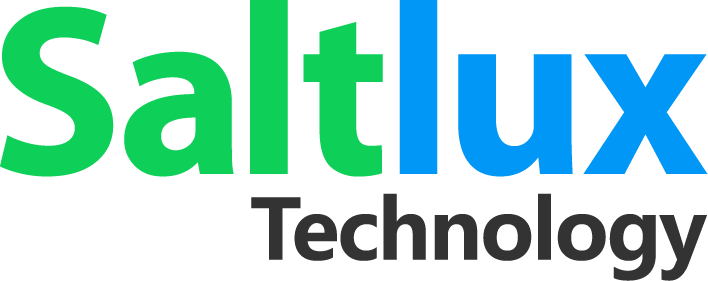Recently, customers’ interest and demand for the use of consulting record data, VOC analysis combined with big data, Financial Consumer Protection Rules compliance, and banks evaluation according to the receipt of civil complaints by the Financial Supervisory Service are increasing. Companies are preparing for the Sense & Response Management System, which takes the lead to find the entire customer experience and makes rapid responses to customers’ potential demands. In addition, it is becoming more difficult to effectively respond to and understand customers’ opinions as well as complaints about products and services by using the Internet, mobile, social media, etc. In particular, evaluation and complaints of products and services distributed through the Internet and social media but not received by companies are becoming unpredictable risks in the future.
Saltlux’s VOC Analysis Solution collects and integrates with real-time VOC from various channels, such as consulting memos at the Customer Center, email, social media, and portal bulletin boards. It helps secure a more intelligent and proactive leadership for customers, such as the development of new products, reputation management of companies and services, and response to VVIP. It maximizes customer satisfaction by providing an early detection system of abnormalities and a real-time response system. along with analyzing in-depth customer complaints and evaluations.

Customer Problems
It is becoming more difficult to effectively respond and integrally understand VOC (complaints and evaluation) distributed fragmentarily through multiple channels.
Introduction Effects
It enables new business planning, real-time risk management, reputation management, and customer satisfaction maximization by analyzing in-depth data that is automatically collected in real-time from various channels. These data are collected according to types of products, services, customer groups, and complaints
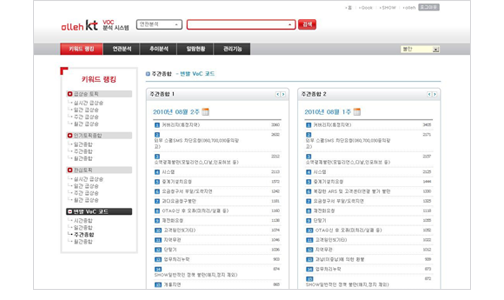
Main Functions
It provides automatic generation of visualization/dashboard, automatic alarming, detection of issues, analysis of trends, emotion analysis, automatic reputation, search, automatic classification, real-time collection, and convergence of all data. It aims to analyze VOC such as consulting memos at a call center, social media, portal bulletin boards, internal DB, and reports.
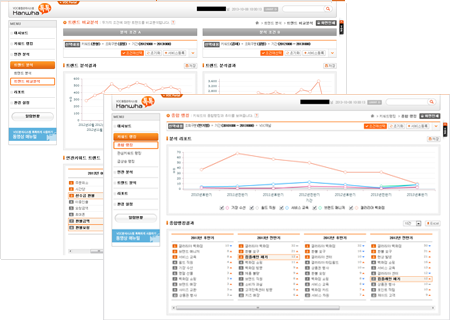
Built-in Products
DISCOVERY, Interworking TORNADO and RAINBOW
Major Customers
KT, Korea Expressway Corporation, Hanwha Group (10 Group Companies), National Health Insurance Service, Industrial Bank of Korea, KEB Hana Bank, Shinhan Bank, Busan Bank, etc.
VOC Definition of VOC System
VOC (Voice Of Customer) refers to various queries, complaints, suggestions, etc. that reflect customer reactions to companies’ services and their management activities. The data comprising the VOC has traditionally been consulting memos of consultants obtained through CRM’s customer support system used mainly at call centers and bulletin boards for customer support. However, now it has grown to include comprehensive data such as customers’ reactions to services and products obtained through various channels including blogs, Twitter, community sites, and other forms.

Saltlux’s VOC Analysis Solution consists of the Information Collection System that collects internal/external informal VOC information, the VOC Analysis System that analyzes the collected information, and the web service that provides the analyzed information on the web. The solution builds consulting record analysis systems by using data collection/analysis solutions such as text mining and related information searches of which functions are optimized. Performance is proven through various building cases to analyze informal data (VOC and consulting records).

The necessity for Analysis of VOC
In the 2000s, large-volume customer consulting memos accumulated on systems by building large-scale call center infrastructure, including CRM systems. In addition, consumers express opinions actively due to the proliferation of the digital environment and the facilitation of the Internet. Especially, due to the emergence of the Web 2.0 paradigm, prosumers who express opinions as consumers through blogs and communities on the Internet have appeared. They actively share their opinions with other users, and by doing so, they exert influence on corporate management. Clearly, understanding various customer needs, and problems and henceforth reflecting them in products/services have a direct relation to the survival of businesses in an increasingly competitive environment.

Main Functions of VOC Analysis System
1. Related Information Analysis/Trends Analysis
By applying topic-ranking technology, the system connects all internal and external related knowledge, then suggests the correlation. It deeply understands customer VOC trends by conducting regular statistical analysis of interest keywords in VOC..
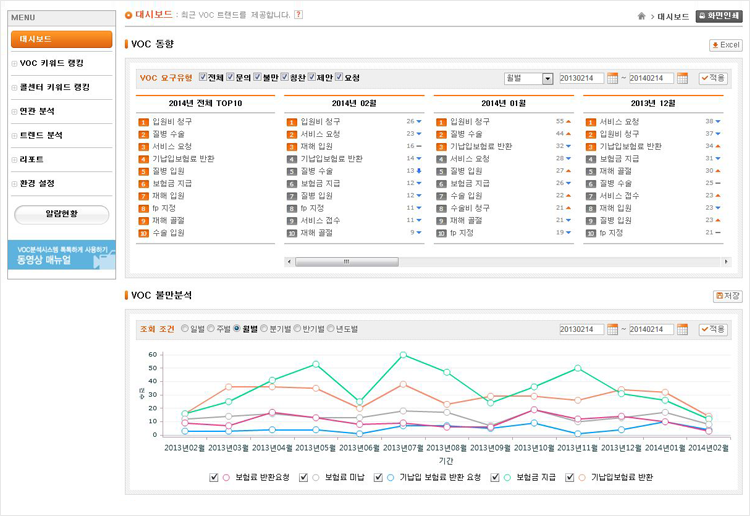
- By applying topic clustering technology, it connects all internal and external related knowledge and discloses the correlation to provide users with insights.
- It verifies related issues occurring around issues by showing correlations and expressing major-related keywords by radar charts.
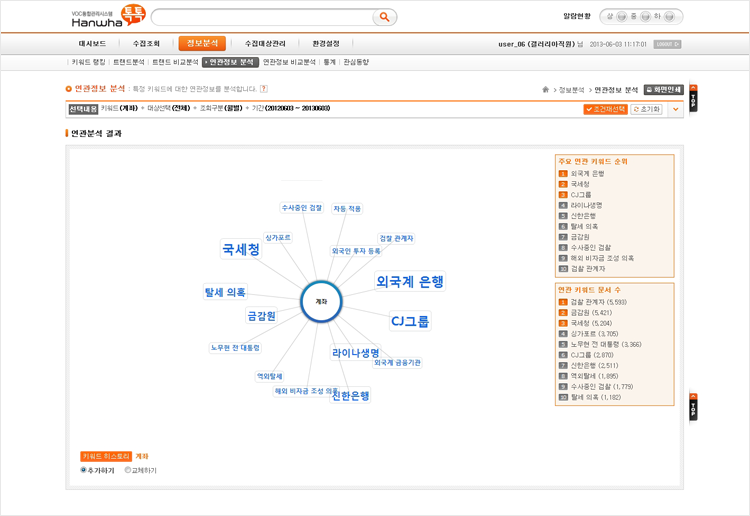
- It provides services by conducting regular statistical analysis of interest terms within the relevant domain through trend analyses.
- Extraction of popular terms to extract frequently mentioned words in the analysis cycle and extraction of sharply increasing terms reflected by the rising tendency of the frequency mentioned in the past based on the analysis time.
2. Visualization of Statistical Information
By quantifying the possibility of issue occurrence, it correctly understands the causes of issues and establishes countermeasures via visualization and dashboards. It analyzes property information by classifying collected consulting information of customers in various statistical methods (frequency, development, and multi-dimensional analysis).
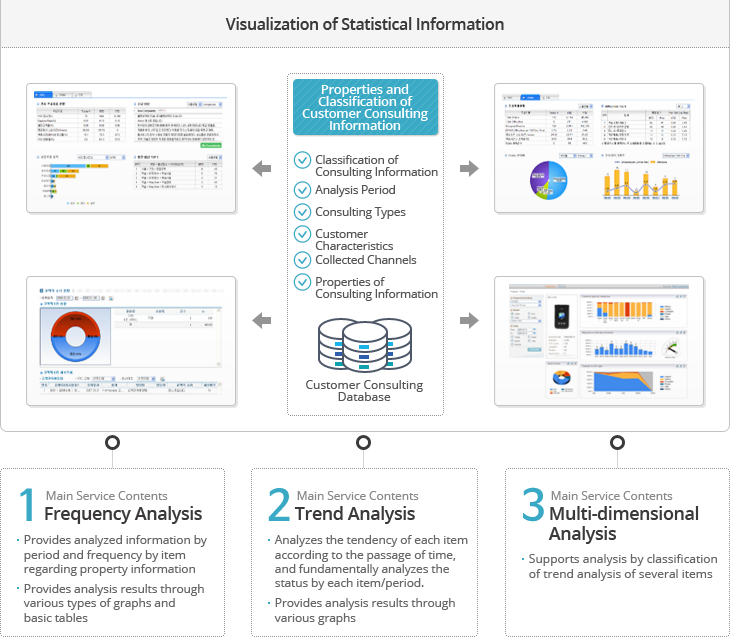
3. General Dashboard
It can view customer demands at once by providing recent trends of VOC in various formats such as period, age, sex, etc.



4. Comprehensive Ranking of Keywords
It can verify continuous VOC issues through comprehensive rankings, understand new emerging issues through sharply increasing rankings, and provide interest keyword rankings to show how the information consumers desire is ranked.
- Inquiry for issue keywords by type (customer/demand/service)
- Development of related keywords about question keywords.
- Inquiry for the best issue keyword results during the relevant period
- Inquiry for the search results of question keywords
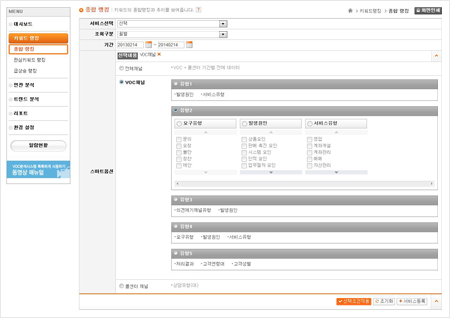
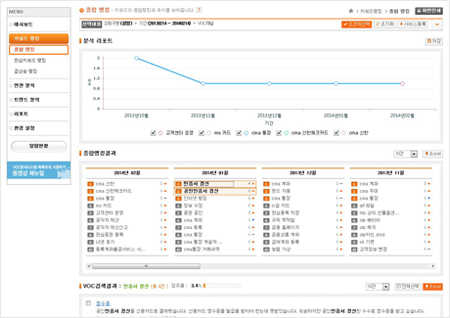
5. Report Function
It provides various types of high visibility reports and statistics regarding analyzed VOC.
- Status requests include keywords by type such as customer demand, service, treatment result, etc.
- Enter multiple keywords when inquiring about types
- Enter exclusion keywords while searching the results
- Inquiry for setting the period




6. Analysis of Related Issues
It inquiries for related issues about internal and external collected information (Twitter, blogs, cafes, etc.) and provides trends analysis.
- Inquiry for ranking of keywords related to interest keywords
- Status of occurrence of related keywords by period
- Ranking by related keyword
- Inquiry for the status of collected data information

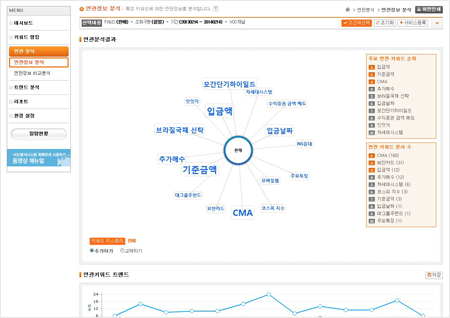
Features of VOC Data
Generally, VOC data has the following content characteristics with each characteristic needs to be applied a suitable analysis technique.
- Short text compared to general documents
A consulting memo is written with short content of 100 characters on average. In some cases, it is not a sentence, but rather an enumeration of keywords about main issues (complaints, defects, etc.)
- Subordination of product/service domain
VOC data is generated from customer-facing management activities such as sales of products and services. Therefore, VOC data includes feedback such as customers’ various complaints, suggestions, and opinions about products and services. It is necessary to secure and build keywords such as product names, service names, customer classification, etc. that can represent domain knowledge about products and services.
- May include sensitive information
When describing consulting contents with customers as they are, it includes various customer information such as name, address, resident registration number, telephone number, card number, etc. Such private information is not exposed to the analysis results, instead, it is filtered through a preprocessing process.
- Description with abbreviation and a colloquial style
VOC data, which is built by counselors at call centers, is prepared during the short consulting time with customers. As a result, it is often written with abbreviations and colloquial styles for the counselors’ convenience. It is needed to consider that such abbreviations and colloquial styles can be effectively processed in the language analysis phase.
- Applying partial standardization
In the effort to use contents within call centers, partially standardized patterns can be stored. However, in reality, it is difficult to conduct pattern-based analysis without exception, as there are many data errors due to various customer feedbacks and rapid personnel replacement of call centers. Therefore, it should process parts described with patterns and other data.
Analysis Technique of VOC Data
Analysis techniques of VOC data using text mining and technology to apply the relevant technique are as follows:
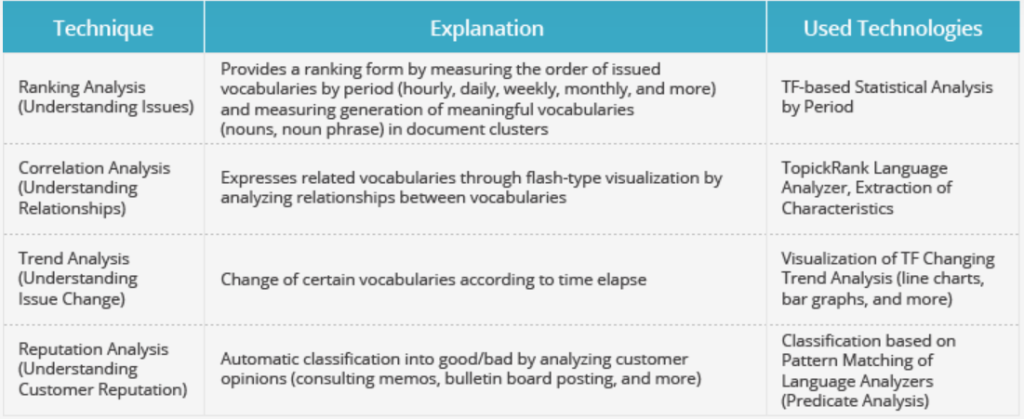
VOC Data Analysis Considerations
- Verification of Data Quality Level
It is necessary to verify VOC data that will be analyzed and shared with customers. Even if the customer realized that the quality of the VOC data was poor, they are likely to overlook content issues after the project was completed.
- Verification of Major Domain Issues
It is necessary to prepare a detailed customer demand scenario from which information is ultimately extracted from VOC to analyze. Without this, the risk will increase over the time spent discussing a project.
- TF (Term Frequency): Measure the frequency of occurrence of a particular keyword in the document
- Topic Rank: Saltlux‘s vocabulary related analysis algorithms, or improvement of Text Rank algorithms
